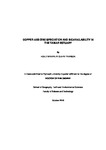Copper and Zinc Speciation in the Tamar Estuary
| dc.contributor.supervisor | Comber, Sean | |
| dc.contributor.author | Pearson, Holly Beverley Clare | |
| dc.contributor.other | School of Geography, Earth and Environmental Sciences | en_US |
| dc.date.accessioned | 2017-07-03T13:50:00Z | |
| dc.date.available | 2017-07-03T13:50:00Z | |
| dc.date.issued | 2017 | |
| dc.date.issued | 2017 | |
| dc.identifier | 10430471 | en_US |
| dc.identifier.uri | http://hdl.handle.net/10026.1/9584 | |
| dc.description | Chapters 3 and 4 of this thesis have been published and are available online (details inside). | en_US |
| dc.description.abstract |
The chemical speciation of trace metals controls their potential bioavailability and therefore toxicity to exposed organisms. Despite previous studies demonstrating the ameliorative effects of dissolved organic carbon (DOC) on metal toxicity, the effectiveness of ligands from varying sources and of potentially variable composition in controlling speciation has not been studied in detail in estuarine waters. In addition, the effect of DOC on radionuclide contaminants in combination with trace metals has not been investigated in any waters. This is of particular interest in the estuarine environment, where both anthropogenic and natural ligands, and contaminants that pose a potential threat to ecosystem health, can be present. Competitive ligand exchange adsorptive cathodic stripping voltammetry (CLE-AdCSV) with complexation capacity titrations was employed to determine the speciation of dissolved Cu and Zn, two metals that possess revised environmental quality standards (EQS) which now account for potential metal bioavailability. Dissolved metal concentrations in the < 0.4 and < 0.2 μm filter fractions of samples from the Tamar Estuary were determined during seasonal transects made over a calendar year. Samples were taken over a full salinity range (0-35) and from locations thought to contain DOC from a variety of sources (e.g. terrigenous, biogenic, sewage). No seasonal trends in metal speciation were identified, but a semi-quantitative assessment of DOC type using 3-D fluorimetry showed domination of humic and fulvic type ligands in the upper estuary, and biogenic-type ligands in the lower estuary, the former appearing the most important in controlling Cu and Zn complexation. Filter size fraction differences showed a major portion of the dissolved metal is associated with the 0.2 ≥ 0.4 μm fraction, indicating an importance of larger molecule ligands in controlling potentially bioavailable metal. Sample ligand concentrations ([L_x]) ranged from 1-372 nM (Cu) and 3-412 nM (Zn), and metal-ligand conditional stability constants (log K_(ML_x )) from 10.5-13.5 (Cu) and 7.5-10 (Zn), which are similar to reported literature. Calculated free metal ion concentrations ([M2+]) of 0.3 – 109 nM (Zn) and 1.4 x 10-13 – 7.3 x 10-11 M (Cu) compared well (92% showed no significant differences (P = 0.02)) with direct measurements of [Zn2+] made for the first time in estuarine waters using “Absence of Gradients and Nernst Equilibrium Stripping” (AGNES) after optimisation for estuarine waters. AGNES fully complements CLE-AdCSV in terms of analytical capability and shows that methods are now available that are capable of directly determining [Zn2+] in estuarine waters for use in environmental monitoring studies. Calculations made using the chemical equilibrium speciation programme Visual MINTEQ (VM) showed [Cu2+] and [Zn2+] could be predicted to within one order of magnitude of measured values when log K_(ML_x ) and [L_x] are determined and input into the model. This was in contrast to poor agreement between measured and predicted [M2+] when VM was used with the NICA-Donnan complexing model, which assumes a set portion of the total DOC concentration input is fulvic acid that actively complexes metals. These results corroborate a lack of identification of a relationship between metal speciation in the Tamar samples and DOC concentration, highlighting that knowledge of DOC type, log K_(ML_x )and L_x are important when assessing environmental risk, setting EQSs and for accurate modeling of [Cu2+]. Finally, a combined chemical and biological study investigating the effects of mixtures of DOC, Zn and the radionuclide tritium (3H) on the marine mussel presents the first evidence of a protective effect of Zn on DNA damage caused by 3H. The association of 3H with DOC remains elusive and an assessment of DOC type is recommended for future research, but the study emphasises the importance of investigating mixture effects in order to avoid inaccurate risk assessment and potentially costly site remediation. | en_US |
| dc.description.sponsorship | International Zinc Association | en_US |
| dc.description.sponsorship | International Copper Association | en_US |
| dc.description.sponsorship | Plymouth University | en_US |
| dc.language.iso | en | |
| dc.publisher | University of Plymouth | |
| dc.rights | CC0 1.0 Universal | * |
| dc.rights.uri | http://creativecommons.org/publicdomain/zero/1.0/ | * |
| dc.subject | Bioavailability | |
| dc.subject | Copper | |
| dc.subject | Zinc | |
| dc.subject | Dissolved organic carbon | |
| dc.subject | Voltammetry | |
| dc.subject | Water Framework Directive | |
| dc.subject | Environmental Quality Standards | |
| dc.subject | Metal speciation | en_US |
| dc.subject.classification | PhD | en_US |
| dc.title | Copper and Zinc Speciation in the Tamar Estuary | en_US |
| dc.type | Thesis | |
| plymouth.version | publishable | en_US |
| dc.identifier.doi | http://dx.doi.org/10.24382/891 | |
| dc.rights.embargoperiod | No embargo | en_US |
| dc.type.qualification | Doctorate | en_US |
| rioxxterms.version | NA |
Files in this item
This item appears in the following Collection(s)
-
01 Research Theses Main Collection
Research Theses Main



